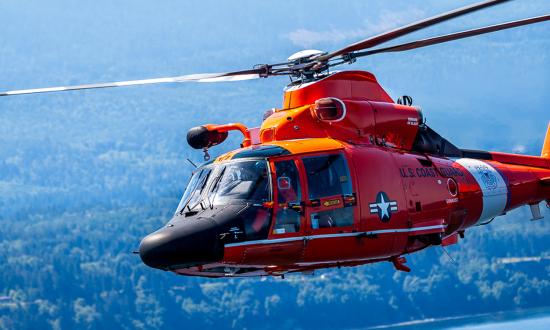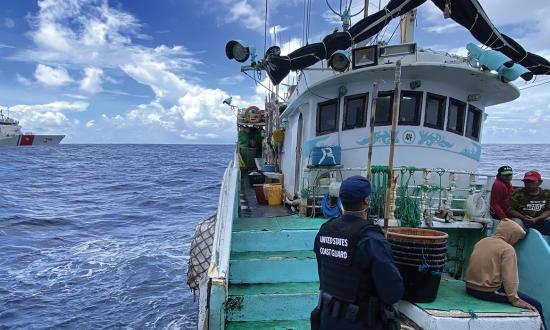Moving cargo and people within and beyond the Marine Transportation System (MTS) fuels the U.S. economy. Protecting and improving the MTS is long overdue. One way the Coast Guard protects the MTS is by operating the Vessel Traffic Service (VTS), which it does using a shore-based surveillance and communication system with the authority to ensure safe and efficient movement of vessels at select ports around the nation. While ships’ masters manage the risk to their vessels, the Coast Guard manages the risk to all harbors and waterways.
The VTS provides monitoring and navigational advice for vessels in particularly confined and busy waterways. There are 12 VTS centers across the United States—ten are managed by the Coast Guard and two are cooperatives to which the Coast Guard provides watchstanders.1 While there is standardization across the VTS centers in terms of sensors and components, each has its own capability feeds, with no interconnection between them. The VTS supports approximately 78,000 vessels per month, or about 2,600 vessels every day, so having the proper sensors to collect and distribute that information is essential.2
Since 1994, participation in the VTS has been mandatory for most types of power-driven commercial vessels and towing vessels while operating in a Coast Guard VTS area. The tools the Coast Guard uses to develop a common operating picture are the VHF radio; Automatic Identification System (AIS) to track the movement of reporting vessels; radar to develop a second, more detailed picture of the vessels as a backup to AIS and detect any vessels not reporting AIS; and cameras to provide a high-resolution picture of the vessels on the water. All this information is consolidated into the Coast Guard Vessel Traffic Management System, called the MTM300. This provides the best picture of the port to Coast Guard watchstanders so they can manage the traffic and minimize the risk inside the port.
Many of the VTS tools are reaching the end of their service lives. As the Coast Guard considers new technologies to replace them, a highly capable multimission radar is a valuable tool, and the service should invest in this technology for its VTS centers.
The International Association of Marine Aids to Navigation and Lighthouse Authorities (IALA) publishes standards related to maritime navigation with respect to harbors and ports. IALA Guideline 1111 details the operational and technical performance requirements for components of a VTS. The first component is radar to detect small targets in heavy clutter conditions or the ability to discriminate between a small versus large target. IALA breaks VTS capability into three categories: basic, standard, and advanced. Any improvements the Coast Guard makes to the VTS should meet the advanced capability of detecting all seven IALA target types.
VTS Radar Use
The requirement for commercial vessels to use AIS shifted the VTS’s primary means of tracking vessels from radar to AIS. However, AIS is not carried on all vessels transiting through a VTS area, AIS can be turned off, and AIS signals can drop out, leaving a gap in situational awareness for the VTS watchstander. Cameras are also heavily used, but, compared with radar, they cannot achieve the range or ability to detect in all weather conditions. Therefore, the VTS uses X-Band radars extensively to manage vessel movement, vessels at anchor, and barges not required to carry AIS.
For instance, VTS New York averages one anchor dragging every four days.3 Radar detects when barges begin to drag anchor. And radar is crucial in detecting and tracking smaller vessels. VTS Puget Sound uses radar to manage vessel traffic around fishing vessels, giving pilots warning about the amount of fishing traffic ahead of them. Radar is also valuable for determining the aspect of the vessel as it transits through the VTS area. VTS Port Arthur has shown several times that there is a large difference between what AIS and radar show regarding the heading of a vessel.4 This is valuable for predicting a vessel’s course through tight and congested shipping lanes. Finally, radar helps determine the length of the vessel. The offset entered into the AIS is not always correct, so the dot on the map may not always represent the center of the vessel. This can have a significant impact on traffic management when the length of a supertanker is a quarter of a mile or a tug boat is pushing 50 barges strapped together down the Mississippi River.
Better Multimission Radars
Several features exist with modern multimission radars that were not available 20 years ago when the original VTS radars were purchased. Most of the in-use original radars use magnetron technology to generate the radio signals. Magnetron technology dominated the radar market for the first 50 years but has several drawbacks, including short operational life, high voltage and power requirements, and noncoherent processing. The magnetron has been replaced with solid-state technology, which uses much less peak power to achieve the same radar coverage, thereby reducing infrastructure costs.5 Solid-state technology takes advantage of coherent processing that allows users to measure a target’s speed. Solid-state technology also allows multifrequency transmission, which is useful if a particular frequency is experiencing high noise, and provides longer operational life with graceful degradation (the power drop after a failure is gradual, allowing the operator to intervene).
Today’s radar vendors also offer pulse compression. Shorter pulses result in better range resolution. Unfortunately, this reduces the average power placed on the target. Longer pulses deliver more energy on the target but sacrifice range resolution. So, it would seem operators cannot optimize range resolution and energy on the target simultaneously. However, pulse compression techniques allow a radar to optimize the energy of a long pulse while achieving the range resolution of a short pulse at the same time.
Scanning or surveillance radars are designed to rotate 360 degrees in the horizontal plane with a frequency between 5 and 50 rotations per minute. This rotation moves the radar beam so it can detect targets at any angle. The drawback to this method is that the radar can obtain an update on a target only when the antenna comes back to that angular sector. Also, many of the VTS geographies do not require 360 degrees of coverage. Staring radars are new to the market and can achieve bearing resolution comparable to surveillance radars. A staring radar radiates energy over a desired coverage sector with a broad-beam transmit antenna and receives the echo with multiple narrow beams, with each beam staring in a single fixed direction. This allows for more updates on the target while eliminating time wasted scanning areas over land.
A Better Sensing Concept
A concept the Coast Guard may want to adopt is using less-expensive and less-precise radars. Antenna length is proportional to radar angular resolution. A long antenna will deliver a sharp narrow beam for high angular resolution, while a short antenna will provide a broad antenna beam with low angular resolution. Larger antennas equate to larger infrastructure and increased installation, operations, and maintenance costs.
If the Coast Guard were to use a greater number of less-expensive radars with smaller antennas and reduced infrastructure requirements, it could deliver the same radar picture to the VTS operator. The placement of additional sensors should consider the geometry of where they are placed to maximize their impact. The placement of smaller radars at crossing angles should be achievable, as a majority of the traffic lanes are bounded by land on either side.
But there are several unknowns with this concept. Any gains achieved by using less-precise or inexpensive radars may be offset by the cost of additional radar processors or lease fees for additional locations. For example, VTS New York pays $110,000 per year in rent for 11 locations. The last unknown is how the MTM300 will fuse the data from multiple sources if the resolution has been degraded. Additional studies should be conducted to answer these questions.
VTS radars support the Coast Guard’s maritime accident prevention and MTS management missions. However, the VTS mission is challenged by obsolete radar systems. Adopting the latest generation of smaller, less-expensive scanning or staring radars that use continuous-wave transmission could make the VTS radar capability more flexible and agile. This will help bring the VTS technology and service up to the latest standards and keep pace with preeminent maritime ports such as Rotterdam, Singapore, and Shanghai.
1. The 12 U.S. VTS centers are: New York; St. Mary’s River, Michigan; Louisville, Kentucky; Tampa, Florida (cooperative); Lower Mississippi River, Louisiana; Berwick Bay, Louisiana; Port Arthur, Texas; Houston/Galveston, Texas; Los Angeles/Long Beach, California (cooperative); San Francisco, California; Puget Sound, Washington; and Prince William Sound, Alaska.
2. Hugh Roarty, Chris Shivock, and Michael Smith, “Analysis of Radar Within Coast Guard VTS,” Final Report, Maritime Security Center, A Department of Homeland Security Center of Excellence, 2020.
3. U.S. National Transportation Safety Board Safety Study, “An Assessment of the Effectiveness of the U.S. Coast Guard Vessel Traffic Service System,” 13 September 2016.
4. Personal communication with Mr. John Moore, electronics materials officer with VTS Port Arthur, Texas.
5. Felicia Amato, Michele Fiorini, Sergio Gallone, and Giovanni Golino, “Fully Solid State Radar for Vessel Traffic Services,” 11th International Radar Symposium, 16 June 2010, 1–5.






